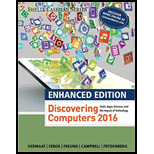
Enhanced Discovering Computers 2017 (Shelly Cashman Series) (MindTap Course List)
1st Edition
ISBN: 9781305657458
Author: Misty E. Vermaat, Susan L. Sebok, Steven M. Freund, Mark Frydenberg, Jennifer T. Campbell
Publisher: Cengage Learning
expand_more
expand_more
format_list_bulleted
Expert Solution & Answer
Chapter 12, Problem 4IR
Explanation of Solution
Java security flaws from two articles:
- As java in browser is
Operating System (OS) independent and it has the popular run-time environment in desktop browsers, java becomes more attractive target for malicious attacker. - Oracle is decided to move rapidly to fix the java flaws.
- In 2013, Oracle released a critical one-off path update to fix the issue before two weeks of the issue being actively exploited...
Explanation of Solution
Processes of informing users about the need to obtain updates to fix security holes:
- A Critical Patch Update
program is a group of patches for various security vulnerabilities where patches are a set of changes such as update, and fixing the data to a computer system. - Oracle informs the users that they need to be remains in actively supported version and apply for the Critical Patch Update program.
- Critical Patch Update program releases the patches for the product versions covered by premier support or extended support of Lifetime Support Policy...
Explanation of Solution
In the world, there are 5 to 10 billion devices have java installed.
Devices that have java installed:
- In the world, 1.1 billion desktop systems run java...
Explanation of Solution
Ways to identify whether java is installed on a computer
- If the user uses command prompt to identify the installation of java.
- After installing java, the user needs to set “PATH” variable in environmental variables.
- Then, the user types the command “java –version” in terminal.
- After running the above command, if java is installed on a computer then it shows the version of java, java Standard Edition (SE) Environment’s build and Java HotSpot client Virtual Machine’s (VM) build.
- The user can also use program that reads java system properties to identify whether it is installed or not...
Expert Solution & Answer
Want to see the full answer?
Check out a sample textbook solution
Students have asked these similar questions
Create a relationship between the common field (Technician Number) of the two tables. Make sure that each client must have 1 and only 1 technician assigned, and each technician can have multiple clients.
2. Create a query to show the Client Number, Client Name, Billed, Paid for clients in Anderson city. Save the query.
3. Create a query to show the Technician Number, Last Name, First Name, YTD Earnings for technicians whose Hourly Rate is greater than or equal to 30. Save the query.
4. Create a query to show Client Number, Client Name, Billed, Paid for clients whose technician number is 22 and whose Billed is over 300. Save the query.
5. Create a query to show the Technician Number, Last Name, First Name, Client Number, Client Name for clients whose technician number 23. Save the query.
6. Create a query to show the Technician Number, Last Name, First Name, Client Number, Client Name for clients whose technician number 23 or 29. Save the query Help please Microsoft office access
Dijkstra's Algorithm (part 1). Consider the network shown below, and Dijkstra’s link-state algorithm. Here, we are interested in computing the least cost path from node E (note: the start node here is E) to all other nodes using Dijkstra's algorithm. Using the algorithm statement used in the textbook and its visual representation, complete the "Step 0" row in the table below showing the link state algorithm’s execution by matching the table entries (i), (ii), (iii), and (iv) with their values. Write down your final [correct] answer, as you‘ll need it for the next question.
4. |z + 5 - 5i| = 7
Chapter 12 Solutions
Enhanced Discovering Computers 2017 (Shelly Cashman Series) (MindTap Course List)
Ch. 12 - Prob. 1SGCh. 12 - Prob. 2SGCh. 12 - Prob. 3SGCh. 12 - Prob. 4SGCh. 12 - Prob. 5SGCh. 12 - Prob. 6SGCh. 12 - Prob. 7SGCh. 12 - Prob. 8SGCh. 12 - Prob. 9SGCh. 12 - Prob. 10SG
Ch. 12 - Prob. 11SGCh. 12 - Prob. 12SGCh. 12 - Prob. 13SGCh. 12 - Prob. 14SGCh. 12 - Prob. 15SGCh. 12 - Prob. 16SGCh. 12 - Prob. 17SGCh. 12 - Prob. 18SGCh. 12 - Prob. 19SGCh. 12 - Prob. 20SGCh. 12 - Prob. 21SGCh. 12 - Prob. 22SGCh. 12 - Prob. 23SGCh. 12 - Prob. 24SGCh. 12 - Prob. 25SGCh. 12 - Prob. 26SGCh. 12 - Prob. 27SGCh. 12 - Prob. 28SGCh. 12 - Prob. 29SGCh. 12 - Prob. 30SGCh. 12 - Prob. 31SGCh. 12 - Prob. 32SGCh. 12 - Prob. 33SGCh. 12 - Prob. 34SGCh. 12 - Prob. 35SGCh. 12 - Prob. 36SGCh. 12 - Prob. 37SGCh. 12 - Prob. 38SGCh. 12 - Prob. 39SGCh. 12 - Prob. 40SGCh. 12 - Prob. 41SGCh. 12 - Prob. 42SGCh. 12 - Prob. 43SGCh. 12 - Prob. 44SGCh. 12 - Prob. 45SGCh. 12 - Prob. 1TFCh. 12 - Prob. 2TFCh. 12 - Prob. 3TFCh. 12 - Prob. 4TFCh. 12 - Prob. 5TFCh. 12 - Prob. 6TFCh. 12 - Prob. 7TFCh. 12 - Prob. 8TFCh. 12 - Prob. 9TFCh. 12 - Prob. 10TFCh. 12 - Prob. 11TFCh. 12 - Prob. 12TFCh. 12 - Prob. 1MCCh. 12 - Prob. 2MCCh. 12 - Prob. 3MCCh. 12 - A(n) _____ report consolidates data usually with...Ch. 12 - Prob. 5MCCh. 12 - Prob. 6MCCh. 12 - Prob. 7MCCh. 12 - Prob. 8MCCh. 12 - Prob. 1MCh. 12 - Prob. 2MCh. 12 - Prob. 3MCh. 12 - Prob. 4MCh. 12 - Prob. 5MCh. 12 - Prob. 6MCh. 12 - Prob. 7MCh. 12 - Prob. 8MCh. 12 - Prob. 9MCh. 12 - Prob. 10MCh. 12 - Prob. 2CTCh. 12 - Prob. 3CTCh. 12 - Prob. 4CTCh. 12 - Prob. 5CTCh. 12 - Prob. 6CTCh. 12 - Prob. 7CTCh. 12 - Prob. 8CTCh. 12 - Prob. 9CTCh. 12 - Prob. 10CTCh. 12 - Prob. 11CTCh. 12 - Prob. 12CTCh. 12 - Prob. 13CTCh. 12 - Prob. 14CTCh. 12 - Prob. 15CTCh. 12 - Prob. 16CTCh. 12 - Prob. 17CTCh. 12 - Prob. 18CTCh. 12 - Prob. 19CTCh. 12 - Prob. 20CTCh. 12 - Prob. 21CTCh. 12 - Prob. 22CTCh. 12 - Prob. 23CTCh. 12 - Prob. 24CTCh. 12 - Prob. 25CTCh. 12 - Prob. 26CTCh. 12 - Prob. 27CTCh. 12 - Prob. 28CTCh. 12 - Prob. 29CTCh. 12 - Prob. 1PSCh. 12 - Prob. 2PSCh. 12 - Prob. 3PSCh. 12 - Prob. 4PSCh. 12 - Prob. 5PSCh. 12 - Prob. 6PSCh. 12 - Prob. 7PSCh. 12 - Prob. 8PSCh. 12 - Prob. 9PSCh. 12 - Prob. 10PSCh. 12 - Prob. 11PSCh. 12 - Prob. 1.1ECh. 12 - Prob. 1.2ECh. 12 - Prob. 1.3ECh. 12 - Prob. 2.1ECh. 12 - Prob. 2.2ECh. 12 - Prob. 3.1ECh. 12 - Prob. 3.2ECh. 12 - Prob. 1IRCh. 12 - Prob. 2IRCh. 12 - Prob. 4IRCh. 12 - Prob. 5IRCh. 12 - Prob. 1CTQCh. 12 - Prob. 3CTQCh. 12 - Prob. 4CTQ
Knowledge Booster
Similar questions
arrow_back_ios
SEE MORE QUESTIONS
arrow_forward_ios
Recommended textbooks for you
 Principles of Information Systems (MindTap Course...Computer ScienceISBN:9781285867168Author:Ralph Stair, George ReynoldsPublisher:Cengage Learning
Principles of Information Systems (MindTap Course...Computer ScienceISBN:9781285867168Author:Ralph Stair, George ReynoldsPublisher:Cengage Learning Fundamentals of Information SystemsComputer ScienceISBN:9781305082168Author:Ralph Stair, George ReynoldsPublisher:Cengage Learning
Fundamentals of Information SystemsComputer ScienceISBN:9781305082168Author:Ralph Stair, George ReynoldsPublisher:Cengage Learning Systems ArchitectureComputer ScienceISBN:9781305080195Author:Stephen D. BurdPublisher:Cengage Learning
Systems ArchitectureComputer ScienceISBN:9781305080195Author:Stephen D. BurdPublisher:Cengage Learning Fundamentals of Information SystemsComputer ScienceISBN:9781337097536Author:Ralph Stair, George ReynoldsPublisher:Cengage Learning
Fundamentals of Information SystemsComputer ScienceISBN:9781337097536Author:Ralph Stair, George ReynoldsPublisher:Cengage Learning A+ Guide To It Technical SupportComputer ScienceISBN:9780357108291Author:ANDREWS, Jean.Publisher:Cengage,
A+ Guide To It Technical SupportComputer ScienceISBN:9780357108291Author:ANDREWS, Jean.Publisher:Cengage, Management Of Information SecurityComputer ScienceISBN:9781337405713Author:WHITMAN, Michael.Publisher:Cengage Learning,
Management Of Information SecurityComputer ScienceISBN:9781337405713Author:WHITMAN, Michael.Publisher:Cengage Learning,

Principles of Information Systems (MindTap Course...
Computer Science
ISBN:9781285867168
Author:Ralph Stair, George Reynolds
Publisher:Cengage Learning

Fundamentals of Information Systems
Computer Science
ISBN:9781305082168
Author:Ralph Stair, George Reynolds
Publisher:Cengage Learning

Systems Architecture
Computer Science
ISBN:9781305080195
Author:Stephen D. Burd
Publisher:Cengage Learning

Fundamentals of Information Systems
Computer Science
ISBN:9781337097536
Author:Ralph Stair, George Reynolds
Publisher:Cengage Learning

A+ Guide To It Technical Support
Computer Science
ISBN:9780357108291
Author:ANDREWS, Jean.
Publisher:Cengage,

Management Of Information Security
Computer Science
ISBN:9781337405713
Author:WHITMAN, Michael.
Publisher:Cengage Learning,